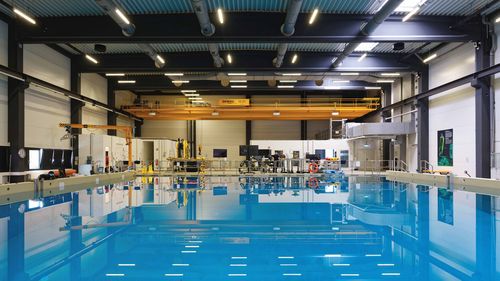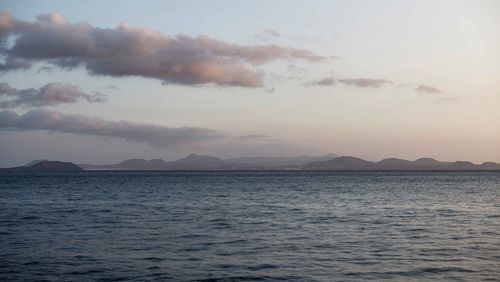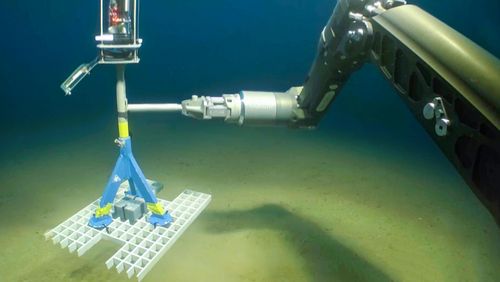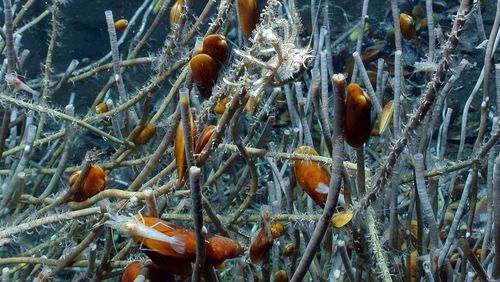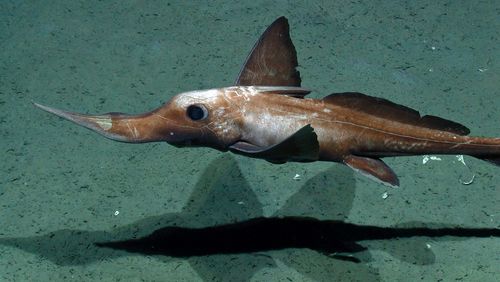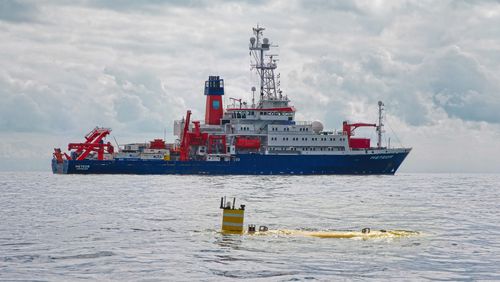Who wants what where?
Some 30 companies hold a contract to explore the deep sea for resources. Where are the treasures hidden? And who wants them? A brief introduction.
1 Black smokers
In some areas of the deep sea, the seabed is alive with volcanic activity. This is where “black smokers”—or hydrothermal vents—often form: small chimney-like structures that emit a plume of dark-coloured water heated by the magma. The black hue is due to the abundance of minerals the super-hot water (400 degrees Celcius) washes from the volcanic rock. Upon entering the cold seawater, the minerals are precipitated and cascade to the seabed near the black smoker. The resulting deposits are called “massive sulphides”, as they are made of sulphur com-pounds. They are often extremely rich in metals: gold and silver, copper, lead, zinc and the high-tech metals indium, germanium, bismuth and selenium. These metals are why the black smokers are so interesting to deep-sea mining companies. Numerous black smokers are found on the mid-oceanic ridges, deep oceanic basins (back-arc spreading zones) and near volcanic arcs, where highly diverse life forms in unique ecosystems thrive—explaining why hydrothermal vents are often termed the “oases of the deep sea”.
2 Polymetallic nodules
Polymetallic nodules (also called manganese nodules) are potato-shaped lumps of rock that form on loose sediment on the sea floor at depths between 3000 and 6000 metres. They contain large amounts of manganese and valuable elements such as gold, iron, cobalt, copper, zinc and nickel, titanium and traces of rare elements such as molybdenum and tellurium. To form, polymetallic nodules need a special, deep-sea bacterium—and an abundance of time: over the course of one million years, a nodule grows only between 0.2 and 10 centimetres.
3 Polymetallic crusts
Polymetallic crusts are layers of sediment that form on submarine ridges and seamounts. They are between two and twenty-six centimetres thick and, like polymetallic nodules, grow at extremely slow rates—just five millimetres every million years. They contain manganese, cobalt, nickel, copper, platinum, cerium, molybdenum, tellurium and tungsten. The crusts at a depth between 800 and 2500 metres are particularly rich in minerals and have consequently generated commercial interest. Two thirds of all polymetallic crusts are located in the western part of the Central Pacific. In total, the world’s oceans contain some 40 million metric tons of dry ore.
4 Rare earth elements
A string of tectonic fissures connected to volcanoes are located near the Chinese coast; in these fissures, metal deposits rich in rare earth elements have accumulated. The term “rare earth element” is, however, misleading, as metals belonging to this group are not uncommon. What makes them rare is that they occur only in very small amounts. Mining them on land is labour-intensive, complicated, expensive—and detrimental to the environment. For years, China held a monopoly in mining rare earth elements, although the country’s market share has decreased significantly in recent years. Rare earth elements are used primarily for renewable energy technologies (solar panels, wind turbines) and electronics (computers, digital cameras, energy-saving light bulbs). They also form the basis for strong, permanent magnets used in electric motors, generators, and modern high-temperature superconductors. Japanese researchers discovered a large deposit of yttrium and rare earth elements in the Pacific seabed near Minami-tori-shima (Marcus Island) at a depth of 5000 metres. The island is located some 2000 kilometres from the Japanese archipelago.
5 Crude oil and natural gas
It is believed that large reserves of crude oil and natural gas are present in the seabed starting at an ocean depth of 400 metres. The high pressure in these depths makes blowouts extremely difficult to control. Russia, Canada and Denmark (on behalf of Greenland) plan to drill for crude oil and natural gas at the North Pole. Myanmar has huge untapped oil and gas reservoirs in the Bay of Bengal. Numerous companies from China, Thailand, South Korea, India, Japan, the US, France and Australia are supplying the conveyor technology. It is also believed that there is crude oil near the Spratly Islands in the South China Sea; China, Taiwan, Vietnam, Malaysia, Indonesia, Brunei and the Philippines are engaged in an ongoing dispute over ownership.
A Clarion-Clipperton Fracture Zone
The Clarion-Clipperton Fracture Zone in the Pacific Ocean measures 7000 kilometres in length and holds what is currently believed to be the largest reservoir of polymetallic nodules. A contract to explore the zone has been granted to 15 countries and companies domiciled in them. Among the contractors is the German Federal Institute for Geosciences and Natural Resources in Hanover. (Germany also has a contract to search for massive sulphides in the Indian Ocean off the coast of Madagascar.) In 2014, the environmental protection organisation WWF compiled a background study on deep-sea mining and concluded that, due to the long regeneration cycle of the deep sea, mining would essentially destroy the Clarion-Clipperton Fracture Zone.
B Solwara 1
The mining project that has advanced the furthest is Solwara 1, located in the Bismarck Sea in the exclusive economic zone of Papua New Guinea. The corporation Nautilus Mineral, which is domiciled in Canada, has plans to mine the 100 000 ounces of gold and 80 000 metric tons of copper that are believed to be in the massive sulphides at an ocean depth of 1600 metres. The majority stockholders in Nautilus Minerals (two billionaires, from Oman and Russia) have yet to settle the financing; the planned starting date of mining activities in 2019 is therefore questionable. Because the Bismarck Sea is one of the most biodiverse and ecologically significant ocean regions on Earth, worldwide protests have been staged against the Solwara 1 project.
C Atlantis II Deep
In the Red Sea, at a depth of 2000 metres, lies the Atlantis II Deep: a submarine basin that formed when the African Plate and Arabian Plate drifted apart. The Deep is filled with a thick, metal-rich layer of sediment and is believed to harbour the world’s largest sulphide deposits. Three million metric tons of zinc, 700 000 metric tons of copper, 6500 metric tons of silver and 46 metric tons of gold—worth an estimated 12 billion euros—are believed to be present in the sediment.
a International Seabed Authority
In 1982, the United Nations declared the deep sea and its resources to be “common heritage of humankind”. The 1994 UN Convention on the Law of the Sea defined the rights and responsibilities regarding use of the deep sea, including deep-sea mining. For a fee of 500 000 US dollars, the International Seabed Authority ISA, domiciled in Jamaica, grants mining companies exploration contracts if they submit a joint application with a country that assumes responsibility for liability and monitoring. ISA is currently developing a “Mining Code” for excavating polymetallic nodules. In the Code, the following point will be of great ecological relevance: enough protected areas must be designated to ensure that various life forms can repopulate and thrive.
b Innovation Center for Deep-Sea Environmental Monitoring
The Innovation Center for Deep-Sea Environmental Monitoring is financed by the Werner Siemens Foundation. Its primary goal is to conduct research on the hydrothermal vents along the Mid-Atlantic Ridge. Hydrothermal vents are listed vulnerable ecosystems, meaning that mining them would irreversibly destroy them. The researchers are interested in the ecosystems and general environmental factors as well as in how the seabed and water columns adapt and are able to mutate over time and space. In addition, the team at the centre plans to make a series of high-definition optical and acoustic maps of the seabed. This will allow changes to be charted, mainly by comparing the data collected on the environment, including on-site measurements of salinity, the percentage of dissolved oxygen in the water and the pH values in the sediment.
c Germany’s exploration contract
On behalf of the government of Germany, the German Federal Institute for Geosciences and Natural Resources in Hanover has been exploring the contract area of the Clarion-Clipperton Fracture Zone (Pacific) for polymetallic nodules since 2006 and the contract area for massive sulphides in the contract zone in the Central Indian Ocean off the coast of Madagascar since 2015. In the Clarion-Clipperton Fracture Zone, the institute is collaborating with 30 European partners in academia and industry (including MARUM) to conduct a test with the International Seabed Authority in April 2019: in the contract zone of the Clarion-Clipperton Fracture Zone reserved for Germany, at a depth of 4000 metres, a polymetallic nodule collector will harvest polymetallic nodules in a limited area measuring 100 by 900 metres. The consortium is hoping to secure for the first time relevant data on the short- and long-term effects of deep-sea mining on the surrounding environment. The findings will be used to develop monitoring schemes and environmental guidelines for future commercial deep-sea mining projects.
d Extensively researched deep-sea zone
The Hudson Canyon, located south-east of New York, is one of the most extensively researched zones in the North Atlantic. An international consortium of researchers has discovered a vast variety of life forms.
e Deepest waters
At 11 000 metres, the Mariana Trench is the deepest natural point in the ocean. It forms the boundary between two tectonic plates in the western Pacific Ocean and belongs to the Ring of Fire, a roughly 40 000-kilometre-long belt where most of the world’s active volcanoes are located and where most earthquakes occur. At this bottom-most point on Earth, the pressure is 1000 times greater than on land. Researchers believe that this supposedly inhospitable area actually hosts completely unknown life forms—and huge reservoirs of natural gas.
Text: Brigitt Blöchlinger
Illustration: bigfish
> Download illustration (619 KB)

